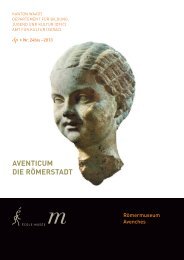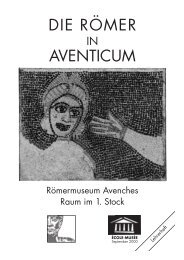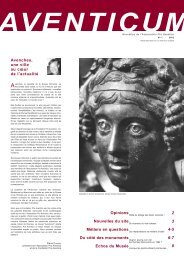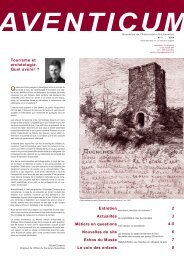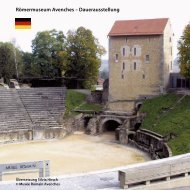Avenches – Roman Museum – Permanent Exhibition
Avenches – Roman Museum – Permanent Exhibition
Avenches – Roman Museum – Permanent Exhibition
Create successful ePaper yourself
Turn your PDF publications into a flip-book with our unique Google optimized e-Paper software.
Second Floor Textile Production<br />
3. Limestone head of a girl.<br />
4-6. Bone counters.<br />
7-9. Glass counters.<br />
10-12. Counters made from pottery or glass sherds; coin turned into counter.<br />
13-27. Glass, bone and ceramic counters, coin turned into counter (1).<br />
28-30. Bone and bronze dice.<br />
31. Ceramic beaker.<br />
32. Fragment of stone game board used for playing ”Twelve Lines” (p. 49, 1).<br />
33. Five lamb bones for playing knucklebones.<br />
Textile Production (2)<br />
(Display case 5)<br />
In <strong>Roman</strong> times, textiles were used to make clothes, tents, blankets, cushions, sails<br />
for boats, sacks, etc.<br />
Wool and linen were the most widely used materials. Silk was very costly as it<br />
was imported from the Orient and it did not appear before the end of the <strong>Roman</strong><br />
Empire. Hemp was mainly used to make ropes, while cotton from the Orient was a<br />
rare commodity.<br />
First, the raw material was prepared for spinning. The plant fibres were obtained<br />
by soaking, beating and drying processes. Then they were combed like wool; it is<br />
possible that carding combs (no. 37), used to disentangle wool, were also used in<br />
linen production. Once the fibres were organised in strands they were wrapped<br />
around distaffs.<br />
For spinning, the strands placed on the distaff were pulled and twisted in order<br />
to obtain a thread wound around a spindle, which was weighted with a spindle<br />
whorl (nos. 1-9).<br />
Weaving was done on a vertical loom where the warp threads were attached at<br />
the top, and straightened by loom-weights usually made of earthenware (nos. 10-12).<br />
Sometimes, patterns such as squares were woven into the cloth or it was<br />
embroidered or painted.<br />
Various items of clothing were made from the cloth. The clothes were sewn<br />
with iron, bronze or bone needles (nos. 13-36). Thimbles protected the dressmakers’<br />
fingers (no. 38).<br />
1-9. Bone spindles; stone and ceramic spindle whorls, two of which were cut from pottery<br />
sherds.<br />
10-12. Terra cotta loom weights used for tightening the warp threads.<br />
13-36. Iron, bronze and bone needles.<br />
37. Iron carding comb.<br />
38. Bronze thimble (3).<br />
1<br />
2<br />
3<br />
50<br />
Second Floor<br />
4<br />
5



